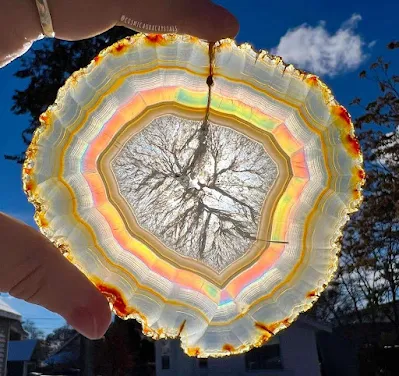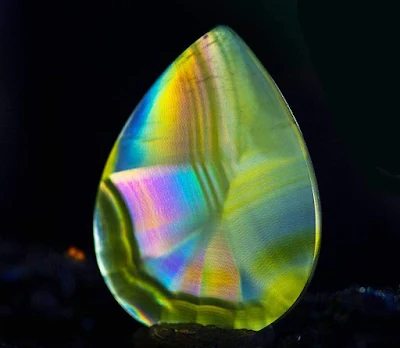Iris Agate: Rainbow Agate
Iris Agate a Rainbow in Stone
Iris agate is a captivating variety of agate that displays an iridescent rainbow of colors when cut into thin slices and viewed with transmitted light. This mesmerizing effect is caused by a diffraction grating formed by alternating layers of silica with different refractive indices. These layers are often so thin that they are invisible to the naked eye, but when light passes through them, it diffracts and creates the rainbow effect.
The rainbow colors of iris agate are not actually pigments within the stone itself. Instead, they arise from the interaction of light with the microscopic structures within the agate. Depending on the dominant colors or patterns of iridescence, Iris Agate can have different names like "Rainbow Agate" or "Peacock Agate."
The name "iris agate" comes from the Greek word "iris," which
means "rainbow." This name is fitting, as the agate's colors are indeed
reminiscent of a rainbow.
 |
| Iris Agate slices |
How is Iris Agate Formed
Iris agates are formed through a complex geological process that involves the deposition of silica-rich fluids in cavities or voids in volcanic rock. As the fluids evaporate, they leave behind layers of chalcedony (a form of silica) that build up over time. The silica bands are very thin and close together, they create a diffraction grating that diffracts light into a rainbow of colors.
Properties of Iris Agate
Appearance: When cut thin and viewed in transmitted light, iris agate exhibits a rainbow of colors. The colors can vary depending on the thickness of the agate and the angle of view.
Composition: Primarily cryptocrystalline quartz (silicon dioxide, SiO2), with minor amounts of other minerals like iron oxides, manganese oxides, and aluminum oxides. The presence and variation of these impurities contribute to its distinct colors and banding.
Color: The distinctive feature of Iris Agate is its iridescence, displaying a rainbow of colors when viewed in transmitted light or at specific angles. The base color can range from light grey to brown, with the iridescent colors including blue, green, purple, and yellow.
Luster: Waxy to greasy to vitreous, depending on the specific composition and polishing.
Hardness: Mohs hardness of 6.5 to 7, similar to other agates, making it reasonably scratch-resistant.
Crystal Form: Does not form true crystals due to its cryptocrystalline nature. Typically occurs as banded, layered, or nodular forms.
Transparency: Translucent to opaque, with the iridescence best observed in translucent pieces.
Fracture: Iris Agate generally exhibits a conchoidal fracture, characterized by smooth, curved surfaces.
Fluorescence: Can exhibit weak fluorescence in various colors depending on the specific composition.
Pleochroism: Absent due to its cryptocrystalline nature.
Refractive Index: 1.53 to 1.54, slightly higher than pure quartz.
Inclusions: May contain inclusions of iron oxides, chalcedony, or other minerals, contributing to its color and sometimes affecting the iridescence.
 |
| Iris Agate shines in a rainbow color when it is hit with light. This slice is from Indonesia Photo: Cosmic Aura Crystals |
Where is Iris Agate Found
While Iris Agate can potentially form in any agate deposit, it's not as common as other agate varieties. That being said, here are some known localities where Iris Agate has been found:
North and South America:
Oregon, USA: Specimens discovered in Oregon have been recognized for their vibrant colors and iridescence.
Montana, USA: Pockets of Iris Agate have been found in various locations throughout the state.
California, USA: Pockets of Iris Agate can be found in the Coast Ranges and Sierra Nevada Mountains.
Rio Grande do Sul, Brazil: This region in southern Brazil is known for its high-quality agates, with some exhibiting iridescence.
Other Locations:
Indonesia: Agates from Indonesia sometimes display iridescence, though confirmation as true Iris Agate might require further examination.
India: Some agate deposits in India have yielded specimens with iridescent qualities.
Madagascar: Occasional agates with iridescence have been found in Madagascar.
Uses of Iris Agate
Iris Agate, with its captivating iridescence and vibrant colors, is primarily used for ornamental and decorative purposes. Here are some common uses of Iris Agate:
 |
| Jewelry Iris Agate Cabochon |
Jewelry:
Iris Agate is often used in the creation of unique and eye-catching jewelry. Cabochons and beads cut from Iris Agate are incorporated into various designs, including pendants, earrings, rings, and bracelets. The stone's iridescence adds a touch of elegance and individuality to jewelry pieces.
Lapidary Art:
Lapidaries and artisans value Iris Agate for its aesthetic qualities, and it is frequently used in the creation of lapidary art. This can include sculptures, carvings, and other artistic creations that showcase the stone's play of colors.
Home Decor:
Small polished or cut pieces of Iris Agate may be used in home decor. These pieces are sometimes displayed as decorative objects, paperweights, or incorporated into ornamental designs. The vibrant colors and unique patterns of Iris Agate make it an attractive addition to interior decor.
Collectibles:
Iris Agate, especially high-quality specimens with intense iridescence, is sought after by collectors of gemstones and minerals. Collectors appreciate the uniqueness of Iris Agate and may acquire specimens for display or inclusion in mineral collections.
Metaphysical and Spiritual Practices:
Some individuals believe that Iris Agate possesses metaphysical properties, including enhancing spiritual awareness, promoting balance, and aiding in personal transformation. As such, Iris Agate may be used in meditation practices or as part of crystal healing layouts.
Artisanal Crafts:
Craftsmen and hobbyists may use Iris Agate in various artisanal projects, such as mosaic work, jewelry-making, or other crafts. The stone's vibrant colors can inspire creativity in artistic endeavors.
Gift Items:
Iris Agate jewelry or small polished pieces can make unique and meaningful gifts. The stone's colorful appearance adds a personal touch to gift items, making them suitable for special occasions.
Conclusion
It's important to note that Iris Agate is valued for its aesthetic qualities, and its unique play of colors makes it a sought-after gemstone for those who appreciate the beauty of natural stones. When used in jewelry or decorative items, Iris Agate should be handled with care to avoid exposure to harsh chemicals and extreme conditions.
See Also:


%20(1).webp)






